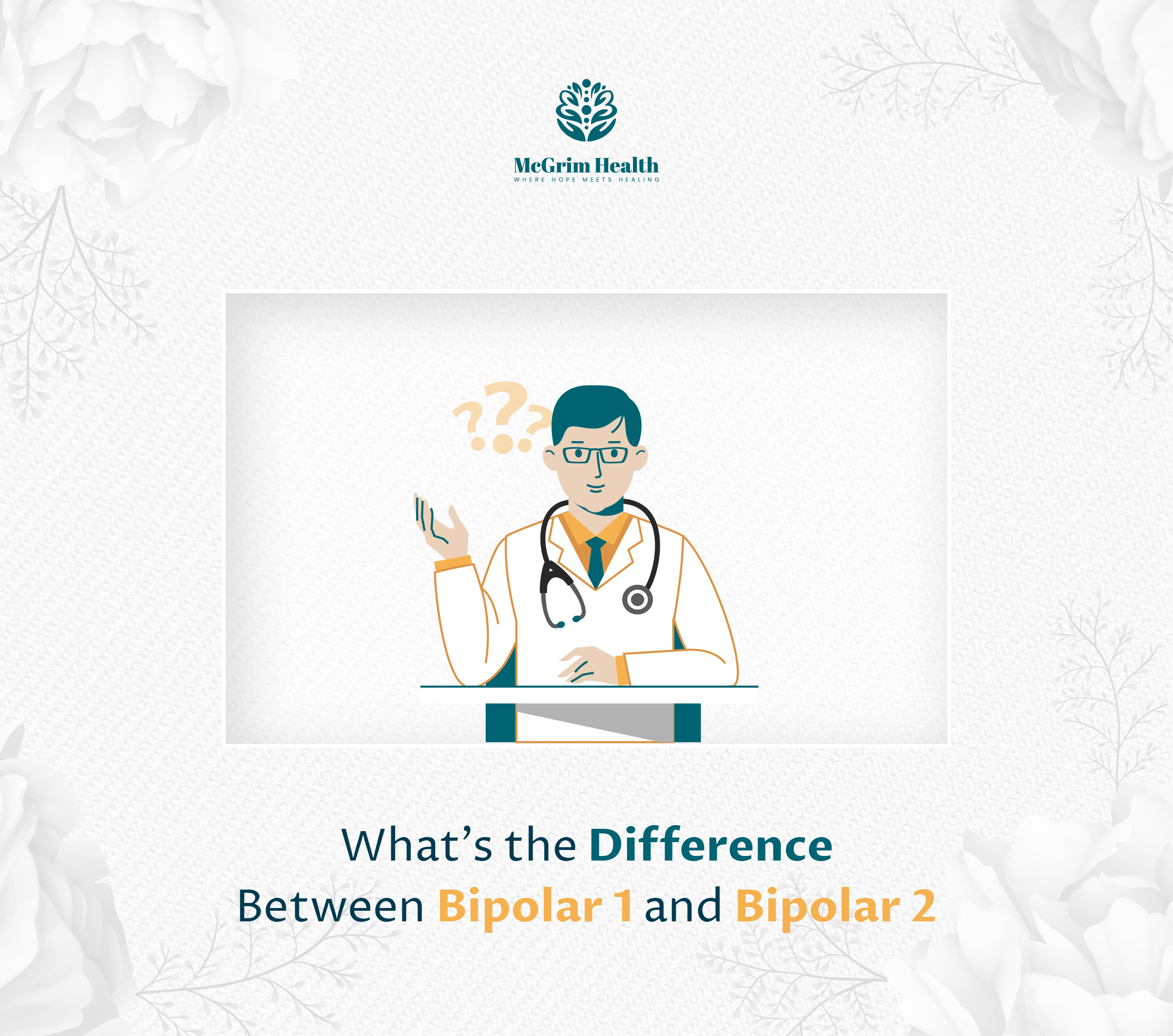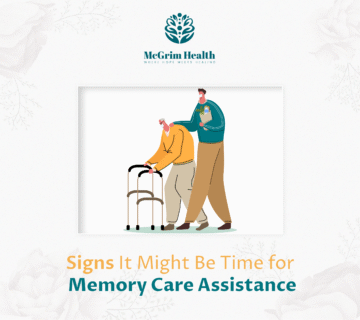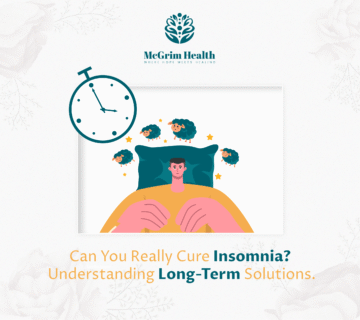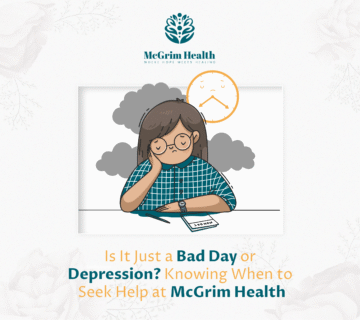Understanding bipolar disorder may seem simple at first. This mental condition includes powerful mood changes, switching between extreme joy and deep sadness, along with peaceful periods.
Digging deeper, bipolar disorder reveals a complexity. Namely, terms like Bipolar 1 and Bipolar 2 crop up, sparking questions. What are the two types? Which one is different, and what is the main difference between them? Let’s explore the bipolar 1 and 2 differences to clarify these questions.
McGrim Health is an expert at delivering mental healthcare, particularly concentrating on comprehension and therapy of bipolar disorder. Contact us now.
Understanding Bipolar 1 and Bipolar 2
There are two types of Bipolar disorders, Bipolar 1 and Bipolar 2. The main feature that makes them stand out is their unique mood swings. Bipolar 1 has periods of high energy called manic episodes. In Bipolar 2, the energy boosts are less intense and are referred to as hypomanic episodes. Both disorders experience a stark contrast with periods of low energy, known as depressive episodes. But what sets these two types of bipolar disorders apart? It hinges on how intense the manic episodes get.
Someone with Bipolar 1 goes through severe manic phases. These tough stages can mess up everyday tasks, sometimes leading to hospital stays. Unlike this, someone with Bipolar 2 has mild manic episodes, which are not as bad as full-blown ones. Bipolar 2 includes longer and repetitive episodes of sadness. Understanding this difference between bipolar 1 and 2 is vital for proper diagnosis and care.
Exploring Bipolar 1 Disorder
A Bipolar 1 diagnosis demands at least one seven-day-long manic episode in a person’s history. This episode, a major stretch of increased energy and abnormally high mood, often triggers behaviors with harsh outcomes. During a manic episode, a person may experience extreme happiness, high levels of energy, and impulsive behavior.
Common symptoms of a manic episode include:
- High energy levels
- Restlessness
- Trouble concentrating
- Feelings of euphoria or extreme happiness
- Engaging in risky behaviors
- Poor sleep
These symptoms can get worse and may require hospitalization to prevent self-harm or harm to others. Strangely enough, someone with Bipolar 1 could undergo periods of depression, or not. This brings more twists to this condition. Here’s where the bipolar differential diagnosis is useful. It separates Bipolar 1 and Bipolar 2 from other mood disorders.
What Is Bipolar 2 Disorder?
Bipolar 2 disorder comes with one big depressive phase that lasts around two weeks and one hypomanic stage. It’s not as strong as the mania in Bipolar 1; Bipolar 2 hypomania is toned down. But, Bipolar 2 also comes with harsh depressive periods. These lows can greatly mess up day-to-day tasks.
Bipolar 2 often gets mistaken for major depression, a problem that surfaces frequently. When people reach out for assistance, it’s generally the symptoms of depression that are more noticeable.
Hypomanic periods might not catch attention since they’re not as intense as total manic episodes, which could cause misinterpretations. That’s why it’s key to tell apart bipolar and mood swings.
How Do Symptoms of Bipolar 1 and Bipolar 2 Differ?
Bipolar 1 and Bipolar 2 differentiate through manic or hypomanic events. Let’s dive in deeper:
Mania in Bipolar 1
In Bipolar 1, a manic episode represents an extremely energetic period, filled with high spirits and potentially nonsensical behavior. In such a stage, doing routine tasks could become challenging due to the elevated mood. Actions may become erratic, such as excessive spending or hasty decision-making, which stand in stark contrast to the person’s usual thought process.
Understanding that external factors such as alcohol, drugs, or other health circumstances, don’t trigger a manic episode is crucial. Grasping this distinction aids in receiving an accurate diagnosis.
Hypomania in Bipolar 2
People with Bipolar 2 experience hypomanic episodes. These are not as intense as the manic episodes in Bipolar 1. During this stage, they might feel an increased sense of productivity and energy. It’s not as extreme as mania. But it still deviates from their regular behavior noticeably. Others are likely to spot this change.
Hypomania seems less problematic than mania. Yet, it can disrupt work and personal connections if not managed well. Recognizing the differences between bipolar 1 and 2 is key to identifying symptoms promptly.
Depression in Bipolar 1 and Bipolar 2
Both Bipolar 1 and 2 show signs of depression. Yet, Bipolar 2 often has these bouts more regularly and intensely. The indicators match those of severe depression, such as:
- Tiredness
- Irritability
- Trouble concentrating
- Changes in sleep and eating habits
- Loss of interest in previously enjoyed activities
- Thoughts of suicide
Feeling down can knock you out. It shows how vital it is to tell the difference between Bipolar 1 and 2, so the right help can be given.
Differences between Unipolar and Bipolar Disorders
Bipolar disorder and unipolar depression differ. Unipolar depression only contains sad periods, free of the mania found in bipolar. Understanding the difference between bipolar and mood swings is crucial. It directs us to the most effective treatments.
For bipolar disorder, the aim is to manage moods that fluctuate. This includes highs (mania) and lows (depression). However, unipolar depression treatment aims mainly at reducing depressive signs. The differences between unipolar and bipolar disorders underline the importance of an in-depth bipolar differential diagnosis. This ensures the correct condition is being treated.
How to Diagnose Bipolar 1 and Bipolar 2?
Bipolar 1 and Bipolar 2 both require a full analysis by a psychiatric professional or mental health specialist. They’ll thoroughly examine the person’s past medical records, current signs, and typical conduct. Essential to diagnosing is grasping the mood episodes. These could be manic, hypomanic, or depressive.
In the process of diagnosis, having a close friend or family member around is good. They can add valuable understanding of one’s actions that the person might fail to see or recall. Also, a physician might need a blood examination. This can eliminate other medical problems with alike symptoms, though no distinct blood test exists for bipolar disorder.
Treatment Options for Bipolar 1 and Bipolar 2
Bipolar 1 and Bipolar 2 are conditions for life, but the right treatment plan can manage them well. Usually, treatment includes both medicine and psychotherapy. Medication like mood balancers, antipsychotics, and mood boosters can control the symptoms. Meanwhile, therapy gives ways to handle life’s hurdles with bipolar disorder.
With Bipolar 1, the key task is to manage manic outbursts and stop them from happening again. Bipolar 2, however, is about handling depressive periods and stopping hypomania from becoming extreme mania. No matter the version, spotting it early and crafting a fitting treatment plan is so important to boost the life quality of people living with bipolar disorder.
Conclusion
It’s vital to grasp the distinction between Bipolar 1 and Bipolar 2 for proper diagnosis and therapy. Both have high and low mood shifts, but their intensity and character contrast sharply. Understanding these contrasts proves helpful in offering appropriate help and bolstering individuals coping with bipolar disorder.
Navigating life with bipolar disorder means staying educated and seeking help. You’ll need to work alongside healthcare providers. People with Bipolar 1 and Bipolar 2 can have rewarding lives. Yes, the disorder poses challenges. But, the right approach can make a big difference.
FAQs
What are manic episodes in Bipolar 1?
In Bipolar 1, manic episodes bring bouts of intense energy and uplifted moods. This can sometimes result in daring actions, even leading to hospital stays.
How is Bipolar disorder diagnosed?
A mental health expert must evaluate closely to diagnose. They look into symptoms, and past health records, and might seek insights from close family or mates.





No comment